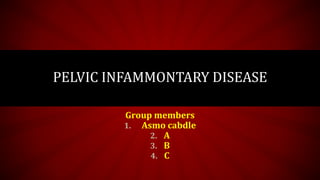Pelvic infammontary disease explatation detail.pptx
•Descargar como PPTX, PDF•
0 recomendaciones•2 vistas
Pelvic in flamontary disease detail information
Denunciar
Compartir
Denunciar
Compartir

Recomendados
Recomendados
Más contenido relacionado
Similar a Pelvic infammontary disease explatation detail.pptx
Similar a Pelvic infammontary disease explatation detail.pptx (20)
PID lecture by Associate Professor Dr Aisha Elbareg

PID lecture by Associate Professor Dr Aisha Elbareg
Último
A rare case of double-diverticulae of the Gallbladder found during a routine elective cholecystectomy is presented including intra operative and specimen images.Gallbladder Double-Diverticular: A Case Report المرارة مزدوجة التج: تقرير حالة

Gallbladder Double-Diverticular: A Case Report المرارة مزدوجة التج: تقرير حالةMohamad محمد Al-Gailani الكيلاني
Último (20)
5CL-ADB powder supplier 5cl adb 5cladba 5cl raw materials vendor on sale now

5CL-ADB powder supplier 5cl adb 5cladba 5cl raw materials vendor on sale now
Hemodialysis: Chapter 2, Extracorporeal Blood Circuit - Dr.Gawad

Hemodialysis: Chapter 2, Extracorporeal Blood Circuit - Dr.Gawad
Tips and tricks to pass the cardiovascular station for PACES exam

Tips and tricks to pass the cardiovascular station for PACES exam
The Orbit & its contents by Dr. Rabia I. Gandapore.pptx

The Orbit & its contents by Dr. Rabia I. Gandapore.pptx
Mgr university bsc nursing adult health previous question paper with answers

Mgr university bsc nursing adult health previous question paper with answers
Hemodialysis: Chapter 1, Physiological Principles of Hemodialysis - Dr.Gawad

Hemodialysis: Chapter 1, Physiological Principles of Hemodialysis - Dr.Gawad
TEST BANK For Lewis's Medical Surgical Nursing in Canada, 4th Edition by Jane...

TEST BANK For Lewis's Medical Surgical Nursing in Canada, 4th Edition by Jane...
5Cladba ADBB 5cladba buy 6cl adbb powder 5cl ADBB precursor materials

5Cladba ADBB 5cladba buy 6cl adbb powder 5cl ADBB precursor materials
Failure to thrive in neonates and infants + pediatric case.pptx

Failure to thrive in neonates and infants + pediatric case.pptx
Gallbladder Double-Diverticular: A Case Report المرارة مزدوجة التج: تقرير حالة

Gallbladder Double-Diverticular: A Case Report المرارة مزدوجة التج: تقرير حالة
Pelvic infammontary disease explatation detail.pptx
- 1. PELVIC INFAMMONTARY DISEASE Group members 1. Asmo cabdle 2. A 3. B 4. C
- 2. PRESENATION OUTLINE A. Introduction B. Causes C. Risk factor D. symptoms E. Diagnosis F. Treatment G. complications
- 3. INTRODUCTION TO PELVIC INFLAMMATORY DISEASE (PID) • Pelvic Inflammatory Disease (PID) is a common infection of the female reproductive organs. • It affects the uterus, fallopian tubes, ovaries, and other pelvic organs. • Often caused by sexually transmitted infections (STIs), particularly chlamydia and gonorrhea.
- 4. CAUSES OF PID PID is primarily caused by the ascending spread of bacteria from the vagina and cervix into the upper reproductive tract. • Common causative agents include sexually transmitted bacteria such as Chlamydia trachomatis and Neisseria gonorrhoeae. • Other bacteria found in the vaginal flora, such as anaerobes and Mycoplasma genitalium, can also contribute to PID.
- 5. RISK FACTORS OF PID • Multiple sexual partners or a partner with multiple partners. • History of previous PID or STIs. • Insertion of an intrauterine device (IUD). • Younger age at first intercourse. • Cigarette smoking.
- 6. SYMPTOMS OF PID • Lower abdominal pain or pelvic pain. • Abnormal vaginal discharge with an unpleasant odor. • Pain during intercourse. • Irregular menstrual bleeding. • Fever and chills. • Nausea and vomiting.
- 7. DIAGNOSIS OF PID • Clinical evaluation, including a pelvic examination to assess for tenderness, abnormal discharge, or masses. • Laboratory tests such as urine analysis, vaginal swabs for culture, and blood tests for inflammatory markers. • Imaging studies such as ultrasound or MRI may be performed to visualize the pelvic organs and assess for complications like abscesses.
- 8. COMPLICATIONS OF PID Chronic pelvic pain: Persistent pain in the pelvic region, impacting quality of life. • Infertility: Scarring and damage to the fallopian tubes and other reproductive organs can lead to infertility or increase the risk of ectopic pregnancy. • Tubo-ovarian abscess: A collection of pus involving the fallopian tubes and ovaries, which may require surgical drainage.
- 9. TREATMENT OF PID • Antibiotics are the main treatment, typically administered empirically to cover a broad spectrum of potential pathogens. • Pain management with analgesics such as nonsteroidal anti- inflammatory drugs (NSAIDs). • In severe cases or when abscesses are present, hospitalization and intravenous antibiotics may be necessary. • Sexual partners should also be treated to prevent reinfection.
- 10. PREVENTION OF PID • Practice safe sex by using barrier contraceptives like condoms and limiting sexual partners. • Undergo regular screening for STIs, particularly if sexually active or at increased risk. • Avoid douching, as it can disrupt the vaginal flora and increase the risk of infections. • Prompt treatment of any suspected STIs to prevent the development of PID and its complications.